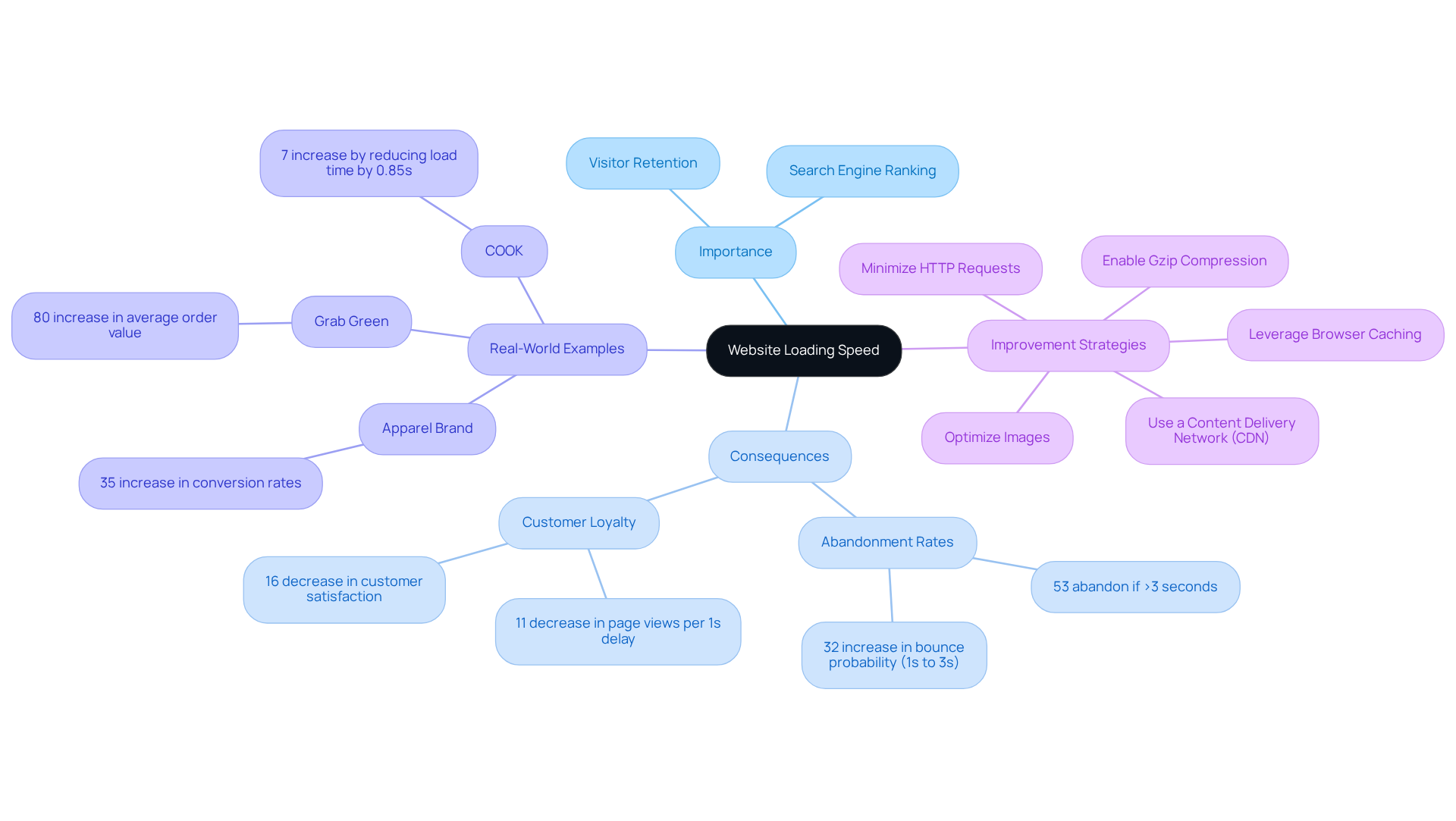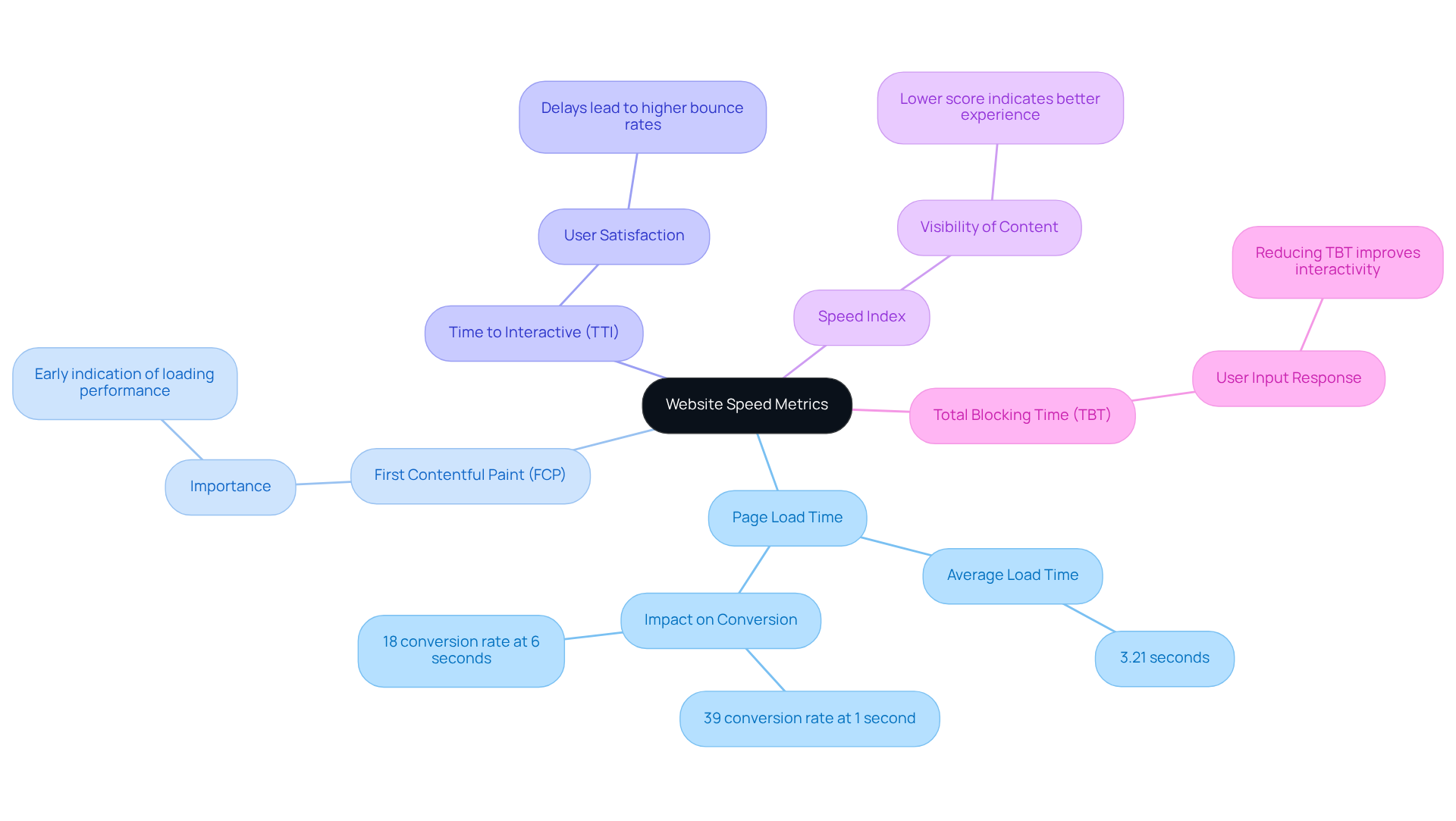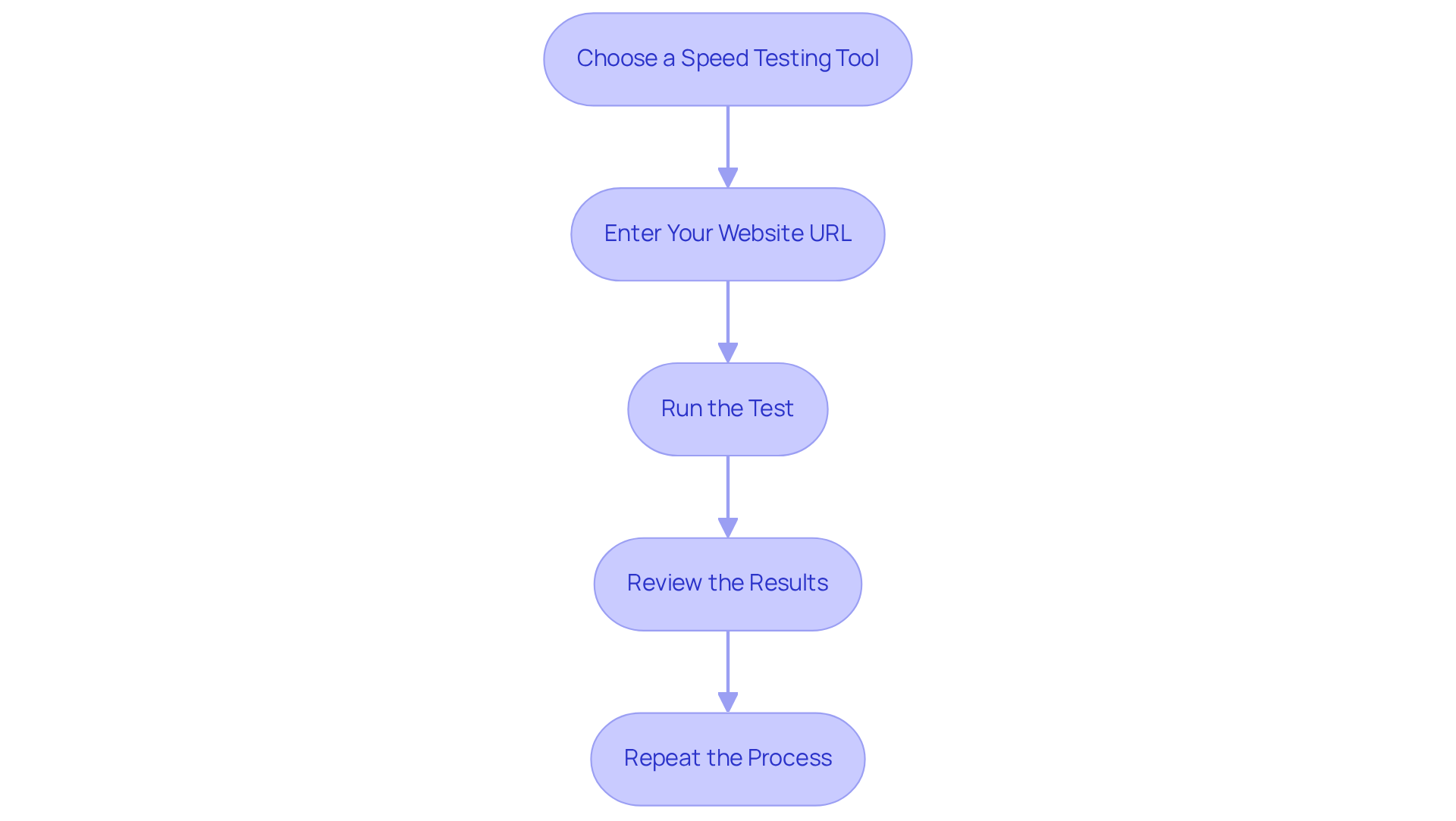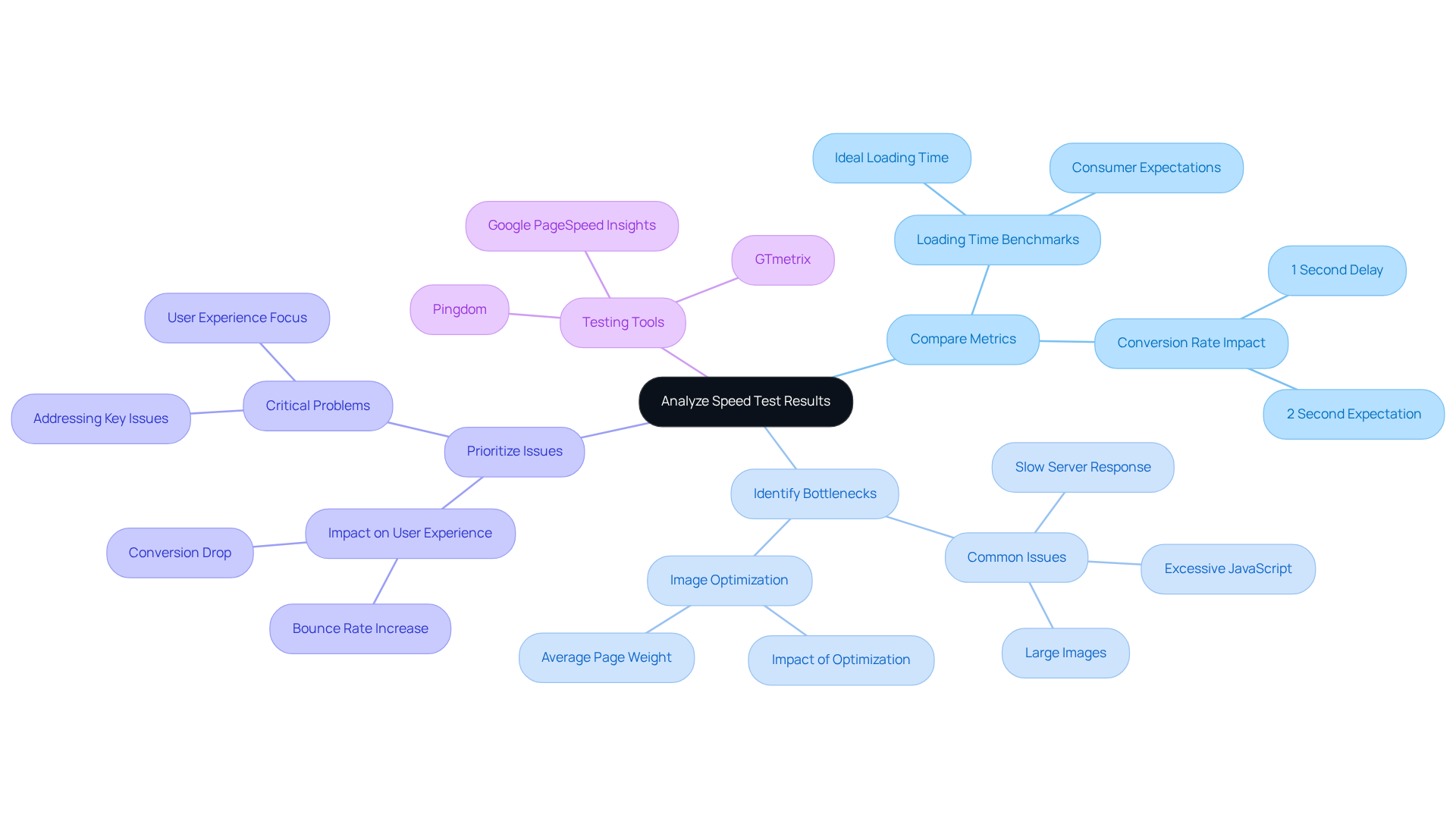
Overview
The article "Master the Loading Speed Test for Your Website: A Step-by-Step Guide" emphasizes the critical importance of effectively testing and improving website loading speed. It articulates the significant impact of loading speed on user retention and conversion rates, providing a comprehensive step-by-step process for conducting speed tests.
Furthermore, it outlines optimization strategies aimed at enhancing website performance. This underscores the assertion that faster loading times not only lead to improved user experiences but also contribute significantly to increased business success.
Introduction
Understanding the critical role of website loading speed is essential for any online business aiming to thrive in a competitive landscape. A staggering 53% of users abandon sites that take longer than three seconds to load, underscoring the urgency to optimize loading times. This guide delves into the intricacies of measuring and enhancing website speed, offering actionable insights that can significantly elevate user experience and boost conversion rates.
However, what hidden pitfalls could be sabotaging a website’s performance? How can businesses effectively navigate these challenges to ensure a seamless online presence?
Understand Website Loading Speed and Its Importance
Website loading speed is the duration it takes for a webpage to fully render its content. A swiftly loading website is essential for retaining visitors; studies indicate that 53% of individuals abandon a site if it takes longer than three seconds to load. This abandonment rate underscores the necessity of optimizing load times to enhance user experience and satisfaction. Moreover, search engines such as Google emphasize loading efficiency as a critical ranking criterion, indicating that a slow site can significantly diminish your visibility in search results.
Real-world examples underscore the relationship between loading time and conversion rates. For instance, a $30M apparel brand that partnered with Parah Group experienced a 35% increase in conversion rates after implementing strategies such as redesigning their homepage to highlight social proof and optimizing product pricing. Similarly, Grab Green, a $15M cleaning product brand, improved their average order value (AOV) by 80% through enhancements that included testing free shipping thresholds and adding bundles to incentivize larger purchases. These statistics illustrate that even minor improvements in efficiency can yield substantial boosts in sales.
The impact of loading time extends beyond immediate visitor retention; it also influences long-term customer loyalty. A study revealed that a one-second delay in page load time can lead to an 11% decrease in page views and a 16% drop in customer satisfaction. This relationship highlights the importance of maintaining optimal loading rates to foster user engagement and retention.
To effectively track and enhance your site's loading performance, consider utilizing tools such as:
- Google PageSpeed Insights
- GTmetrix
- Pingdom
Implementing best practices such as optimizing images, leveraging browser caching, and minimizing HTTP requests can significantly elevate your site's performance.
In summary, mastering loading time is not merely a technical necessity but a strategic imperative that can enhance user satisfaction, reduce bounce rates, and ultimately drive higher conversion rates. By prioritizing speed, as demonstrated by the success of brands similar to those we've collaborated with at Parah Group, you can significantly improve your site's performance and its efficiency in achieving business objectives.

Identify Key Metrics for Measuring Website Speed
To effectively measure website speed, it is crucial to focus on several key metrics:
- Page Load Time: This metric indicates the total time taken for a page to fully load. Research shows that the typical page load time for an online platform is currently about 3.21 seconds (Pingdom), significantly impacting visitor retention and conversion rates. Notably, 53% of mobile visitors abandon a website if it takes more than three seconds to load.
- First Contentful Paint (FCP): This measures the time it takes for the first piece of content to appear on the screen, offering an early indication of loading performance. A quicker FCP enhances user experience and engagement.
- Time to Interactive (TTI): This metric assesses how long it takes for the site to become fully interactive, which is essential for visitor satisfaction. Delays in TTI can lead to higher bounce rates, as visitors may leave a site that appears unresponsive.
- Speed Index: This score reflects how quickly the contents of a document are visibly populated. A lower Speed Index signifies a better experience for users, indicating they can view and interact with content sooner.
- Total Blocking Time (TBT): This measures the duration a page is obstructed from responding to user input. Reducing TBT is vital for improving interactivity and overall site performance.
By closely monitoring these metrics on a loading speed test website, brands can gain valuable insights into their online performance and identify specific areas for improvement. For example, studies indicate that sites loading in one second can achieve conversion rates as high as 39% (Portent), while those taking six seconds experience a dramatic drop to 18%. Utilizing tools such as DebugBear, which provides detailed Page Speed Reports and automated suggestions, alongside Pingdom, known for its uptime and performance tracking, can facilitate efficient monitoring of these metrics, ensuring that your online presence meets the performance standards essential for optimal user engagement.

Conduct a Step-by-Step Website Speed Test
To conduct a website speed test effectively, follow these essential steps:
- Choose a Speed Testing Tool: Begin by selecting a reliable tool, such as Google PageSpeed Insights, GTmetrix, or Pingdom, to ensure accurate results.
- Enter Your Website URL: Input the URL of the site you wish to test into the chosen tool, setting the stage for a comprehensive analysis.
- Run the Test: Click the 'Analyze' or 'Test' button on the loading speed test website to initiate the performance test, allowing the tool to gather critical data on your website's speed.
- Review the Results: Once the test is complete, meticulously review the metrics provided by the tool, focusing on the key indicators identified earlier to assess performance effectively.
- Repeat the Process: To gain a thorough understanding of your site's performance, conduct tests on various sections, ensuring no area is overlooked.

Analyze and Interpret Speed Test Results
After conducting your speed test, it is essential to analyze the results effectively by focusing on the following key areas:
-
Compare Metrics: Examine the key metrics obtained from the speed test and compare them against industry benchmarks. A good loading time should ideally be under 3 seconds, as studies indicate that 79% of online consumers are less likely to revisit slow-loading platforms. In fact, 47% of consumers expect a website to load in 2 seconds or less, and eCommerce sites that load in 1 second can see conversion rates up to 3.05% higher than those that take longer.
-
Identify Bottlenecks: Look for specific areas highlighted by the testing tool that may be causing delays. Common culprits on a loading speed test website include large images, excessive JavaScript, and slow server response times. For instance, images account for 56% of the average web page weight, and optimizing them can significantly improve loading times.
-
Prioritize Issues: Not all identified issues will have the same impact on speed. Prioritize addressing the most critical problems first, particularly those that directly affect user experience and conversion rates. A 1-second delay in page load time can lead to a 7% drop in conversions, and the probability of a bounce increases by 32% when page load time increases from 1 second to 3 seconds, making it essential to tackle the most impactful bottlenecks promptly.
-
Testing Tools: Utilize tools like Pingdom Site Performance Test, GTmetrix, and Google PageSpeed Insights to conduct your performance tests effectively on a loading speed test website and gain insights into your site's efficiency.

Implement Strategies to Improve Website Loading Speed
To enhance your website's loading speed, implement the following strategies with confidence:
- Optimize Images: Compress images without sacrificing quality to significantly reduce load times.
- Minimize HTTP Requests: Limit the number of elements on your page, thereby decreasing the requests made to the server.
- Leverage Browser Caching: Enable caching to store frequently accessed resources, which will reduce load times for returning visitors.
- Utilize a Content Delivery Network (CDN): Disperse your content across various servers to improve accessibility for users in diverse locations.
- Reduce Server Response Time: Optimize your server configuration and consider upgrading your hosting plan if necessary.
By systematically applying these strategies, you will not only enhance your website's loading speed but also improve user experience and increase conversion rates.

Conclusion
Mastering website loading speed is not just important; it is essential for maintaining user engagement and optimizing conversion rates. The impact of swift loading times cannot be overstated; a delay of merely a few seconds can result in significant losses in traffic and customer satisfaction. By prioritizing speed, businesses not only enhance user experience but also improve their visibility on search engines, directly influencing their overall success.
In this article, we have shared critical insights into the necessity of measuring and improving website speed. Understanding essential metrics such as Page Load Time and First Contentful Paint, alongside conducting thorough speed tests with reliable tools, is crucial. Each of these steps plays a vital role in identifying and addressing performance bottlenecks. Real-world examples demonstrate how brands have successfully transformed their online presence through strategic optimizations, leading to heightened conversion rates and increased customer loyalty.
As the digital landscape evolves, ensuring that websites load quickly remains a strategic imperative. By adopting best practices like:
- Image optimization
- Leveraging browser caching
- Utilizing content delivery networks
Businesses can significantly enhance their performance. Embracing these strategies fosters a positive user experience and positions brands for long-term success in an increasingly competitive online environment. Taking decisive action now to master loading speed will yield remarkable benefits for both user satisfaction and business outcomes.
Frequently Asked Questions
What is website loading speed and why is it important?
Website loading speed is the duration it takes for a webpage to fully render its content. It is crucial because a fast-loading website retains visitors; studies show that 53% of individuals abandon a site if it takes longer than three seconds to load. Additionally, search engines like Google prioritize loading efficiency as a key ranking factor.
How does loading speed affect conversion rates?
Loading speed significantly impacts conversion rates. For example, a $30M apparel brand saw a 35% increase in conversion rates after optimizing their website. Similarly, Grab Green, a $15M cleaning product brand, improved their average order value by 80% through enhancements related to loading speed and user experience.
What are the long-term effects of slow loading times on customer loyalty?
Slow loading times can negatively impact long-term customer loyalty. A one-second delay in page load time can lead to an 11% decrease in page views and a 16% drop in customer satisfaction, highlighting the importance of maintaining optimal loading rates.
What tools can be used to track and enhance website loading performance?
Tools to track and enhance website loading performance include Google PageSpeed Insights, GTmetrix, and Pingdom. These tools help monitor loading speed and identify areas for improvement.
What best practices can improve website loading speed?
Best practices for improving website loading speed include optimizing images, leveraging browser caching, and minimizing HTTP requests. Implementing these strategies can significantly enhance site performance.
What are the key metrics for measuring website speed?
Key metrics for measuring website speed include: - Page Load Time: Total time taken for a page to fully load. - First Contentful Paint (FCP): Time for the first piece of content to appear on the screen. - Time to Interactive (TTI): Time taken for the site to become fully interactive. - Speed Index: How quickly the contents of a document are visibly populated. - Total Blocking Time (TBT): Duration a page is obstructed from responding to user input.
How can monitoring these metrics impact conversion rates?
Monitoring these metrics can provide insights into online performance. For instance, sites that load in one second can achieve conversion rates as high as 39%, while those taking six seconds may drop to 18%. This underscores the importance of optimizing loading speed for improved user engagement and conversion.
FAQs











